There are generally only four ways to use power in dancing. Understanding these power sources will improve your dancing significantly.
Ballroom dance movement has changed in a number of ways over the past few decades. Watch videos from the 1950’s and compare the posture and movement to what you see today and you can see that there is much more speed and more volume through the partnership. When properly managed, this can be very beautiful. Many modern couples over-apply one or more of the sources of power in an effort to create greater speed and volume. The result of this excess is movement or shapes that look too wild and lose the character of the dance.
The four sources of power are:
- Gravity Power, which is constantly at work pushing us towards the floor.
- Muscular Power, utilized when engaging various muscles to move the body.
- Centrifugal Force, which is power created on the outside of a turn.
- Centripetal Force, which is power created on the inside of a turn.
I’ll explore each of these in more detail so that you can better understand how to apply them to improve the quality of your dancing.
Gravity, or Kinetic, Power
If you hold a brick at chest height and let go it will probably hit the ground traveling at over 4 meters per second. Watch your toes! The brick has a tremendous amount of built-in power, despite the fact that it is an inanimate object with no internal source of energy.
Gravity is extremely powerful. Every object, as it lowers, has the potential of reaching something called “terminal velocity” which occurs when the sum of its drag force matches the downward force of gravity acting on the object. In other words, we can fall down with enough force to hurt ourselves.
Gravity pushes us downward our entire lives. As a result, we rarely even think about it. A baby learning to walk is very much aware of that heavy force pushing it down, making it hard to stand and to walk. The muscles are not yet developed enough to counter this force. By the time we become old enough to dance, we have mastered the process of pushing back against gravity. When we stand up straight, gravity aligns with our bones and joints to make it quite easy to maintain that posture without a lot of work.
Unfortunately, when we dance, we usually try to control the way gravity works on our bodies. We don’t allow ourselves to lower enough. We fight back. Our effort to control this natural force keeps us from dancing to the capacity we are capable of, because this holds us back and inhibits our use of power.

In the Standard dances, except for Tango, we use a model known as Pendulum Swing for many of the figures. Like the pendulum on a grandfather clock, the minimum amount of movement and highest amount of potential power is at the top of the swing on either side. As the pendulum travels downwards, it gathers kinetic energy, with the maximum amount of energy happening at the bottom of the swing. At this point, it has no more potential power, relying entirely on the power that has already been built up. Fortunately, as humans with joints and limbs and muscles, we can engage the use of those elements to add additional power at the bottom of the swing, allowing a huge amount of additional swing by supplementing the kinetic energy with muscle power. Because Waltz is the best expression of this action, I’ll focus on the Waltz in this article.
Many dancers make the mistake of either applying muscle power too early, before the kinetic energy has been maxed out, or not using the kinetic energy at all, thus relying entirely on muscle power. For example, a common sight in Viennese Waltz is insufficient lowering on step 1, which causes dancers to run out of steam, quickly growing tired because they are trying to muscle their way through this vigorous dance. In addition, they can never achieve the length of stride or amount of speed they are capable of.
Gravity power begins when we relax the joints of our legs and ankles so that we essentially begin “falling” toward the floor. This lowering process generates kinetic energy that we can then borrow to move forward, backward or sideways. As we move towards the point of maximum kinetic energy, we apply muscle power, which I’ll talk about next, to amplify the effect of gravity.
Surprisingly, Gravity power is also used in Tango, though it does not happen through a swing action. Instead, we use compression and take the body slightly out of balance to allow gravitational force to begin moving us forward. We apply muscular power, as in the other dances, to augment that power and create the energy level we are after.
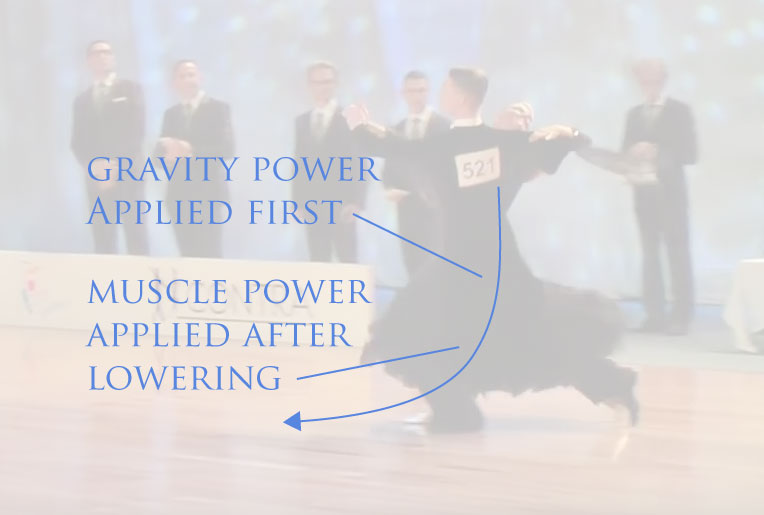
Muscular Power
 Human beings have 650 muscles and 187 joints. We use this in a constant symphony of movement in every activity. The problem in dancing is that we are so used to using these to control our movement that it can be hard to avoid using only muscle power when dancing.
Human beings have 650 muscles and 187 joints. We use this in a constant symphony of movement in every activity. The problem in dancing is that we are so used to using these to control our movement that it can be hard to avoid using only muscle power when dancing.
Beginner dancers typically use only muscular power, as they have not yet learned about the proper use of rise and fall to generate movement. Their movement is small. They tire easily. The more you combine muscle power with natural forces, the greater your speed and volume become, and with less effort.
Take the Natural Turn in Waltz as an example. First we allow Gravity to build kinetic energy by relaxing the legs, causing the body to lower, creating power. Then we apply muscles in the ankles and feet as well as through the thighs, calves and other areas to amplify the power already being generated. At the point of maximum kinetic energy (the center of the pendulum swing), we swing the other foot to the side to continue the flow of energy. We then collect our energy as the kinetic energy bleeds away on the other side of the swing. At the end of count 3 we begin the process all over again. Muscle power must only be applied at the right moment in the downward action of the swing. Applying too early or late creates unattractive swing action.
The challenge is timing the use of gravity and muscular power. When we apply the muscles too early to generate body flight, our dancing looks stiff and makes the couple look as if they are working too hard. In addition, amount of movement is significantly reduced. In contrast, applying the muscles at the right time means we don’t need to use as much muscle power. Dancing looks effortless and easy, with greater movement that happens naturally.
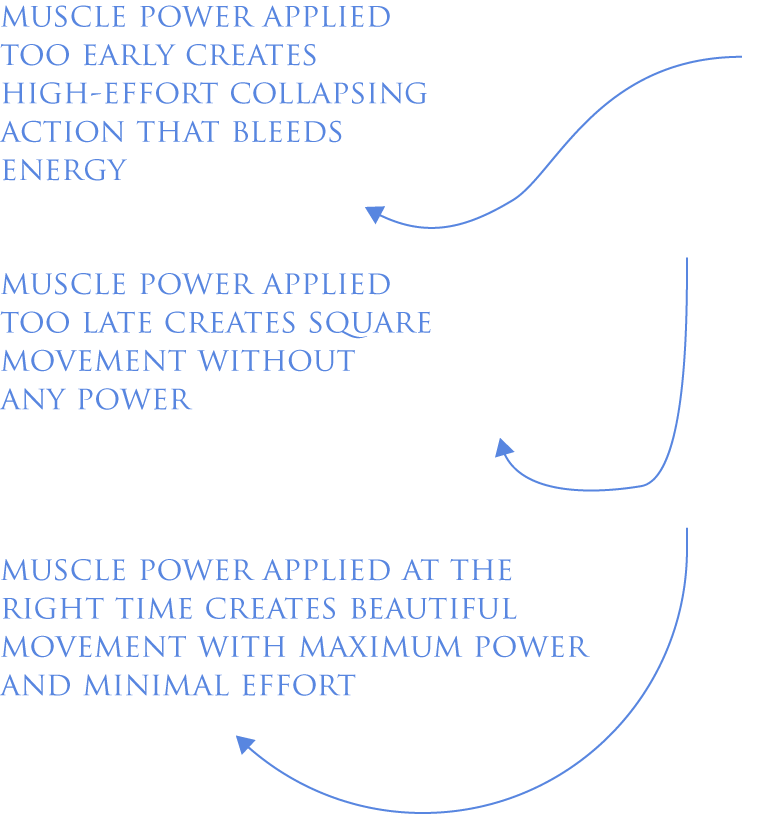
Centrifugal Force
Objects that rotate generate two kinds of energy: centrifugal and centripetal. I talk about this in detail in my article on rotation in dance. Centrifugal force is applied from the center of rotation outwards. As a child you may have experimented with this. I used to marvel at how I could swing a bucket of water upside down without spilling it onto myself at the top of the circle. In most rotational figures, one partner (usually the one going forward) is on the outside of the turn while the other is on the inside. The partner on the outside can use the natural power of Centrifugal force to assist the speed and volume of rotation, helping the couple to move faster with less effort.
Centripetal Force
During rotation, the person on the inside of the turn encounters Centripetal force. This is the same kind of force that a Discus thrower will apply by spinning rapidly around on the spot. While Centrifugal force extends outward during those spins, an equal amount of Centripetal force moves towards the center, creating a greater amount of power. You can see the same force applied when a figure skater pulls their arms in to rotate faster during spins.
When both partners understand Centripetal Force as well as Centrifugal Force, they can work together to optimize the amount of rotation, increasing their volume and again with less effort. Many steps will change from one type of rotation to the other. At that point, the partner who previously used Centripetal energy might now be applying Centrifugal power while the opposite happens for the other partner. This may mean turning the head or applying a swinging action during the rotation. But it must always happen at or near the point of maximum kinetic energy or that effort will be wasted.
When the partner who should be using Centripetal force instead moves laterally or uses Centrifugal force, the other partner must expend more energy to move. This reduces the volume of motion. Both partners need to do their part appropriately.
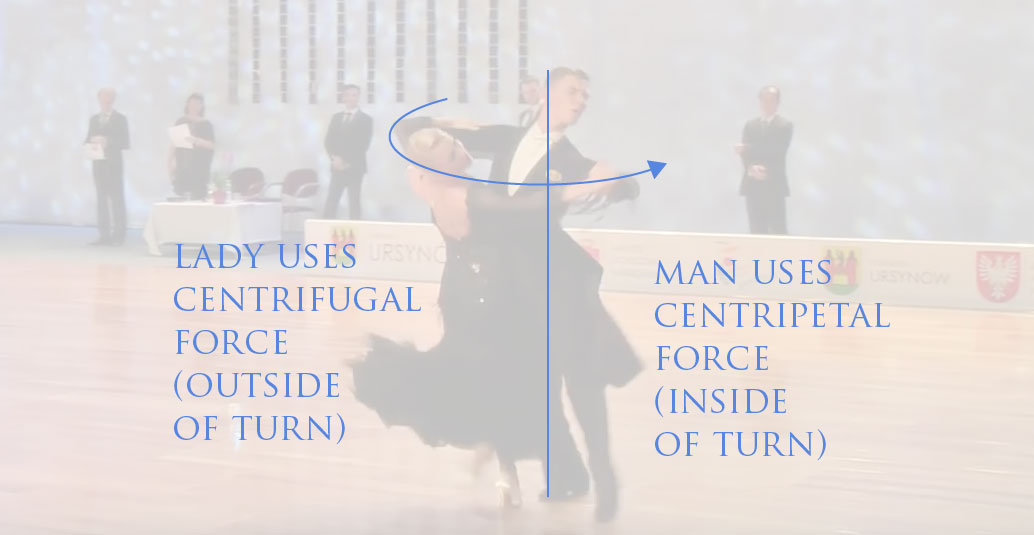
In the example illustrated above, the man is beginning to lead a Throwaway Oversway from Promenade, which is an excellent example of the use of these forces. From the Promenade position, the man, who is in the center of the rotation, must now apply Centripetal power, providing the energy he needs for the Oversway. The lady is on the outside of the rotation. She applies Centrifugal power by keeping her head outside the rotation as she moves into the Oversway. When both partners do their job with the right understanding of these power sources and the correct timing, the result can be more dynamic movement with less “work” required to achieve a great look.
Likewise, in a basic step like the Spin Turn, the man initiates the Pivot using Centripetal power while the lady rotates around him using Centrifugal power. The lady converts her Centrifugal energy to Muscular power to rise, while the man uses Gravity power to move forward onto his right foot, converting this to Muscular power to rise. He then switches to Centrifugal power in the rotation with the lady applying Centripetal power to assist the turn, especially if it is an Overturned Spin Turn. At the end of the turn, the couple applies Gravity power to lower and then Muscular power to swing into the next step such as the 456 of Reverse Turn.
It’s a good idea to review every figure throughout your dance routines and analyze them. Ask yourself which power source you are using and when in each and every step pattern you do. Knowing this will improve your dancing.








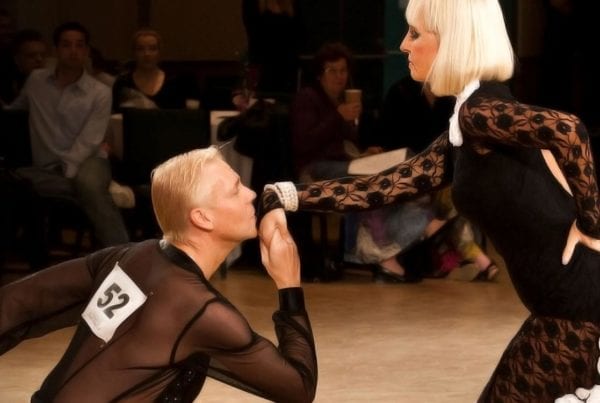
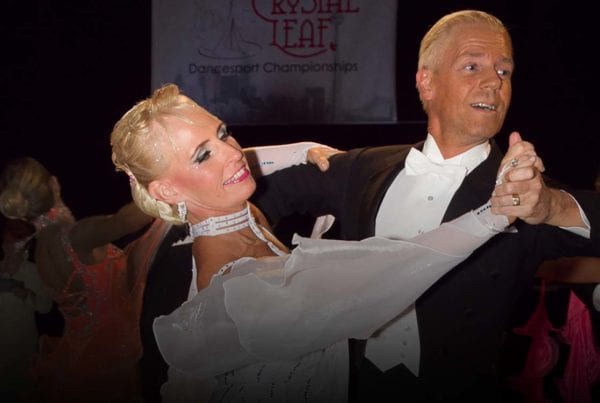




Thank you George! We always love your articles – especially this one which seems so important. Your explanation really helps to plant the idea in our minds so that when we practice/dance, we can incorporate these four ways to use power. Of course to that end, that it helps us become better dancers.
George,
Thank you for the great article, knowing how and when definitely will improve lots of our dancing!
God especially bless those who shared like you.
Best Regards,
Roger